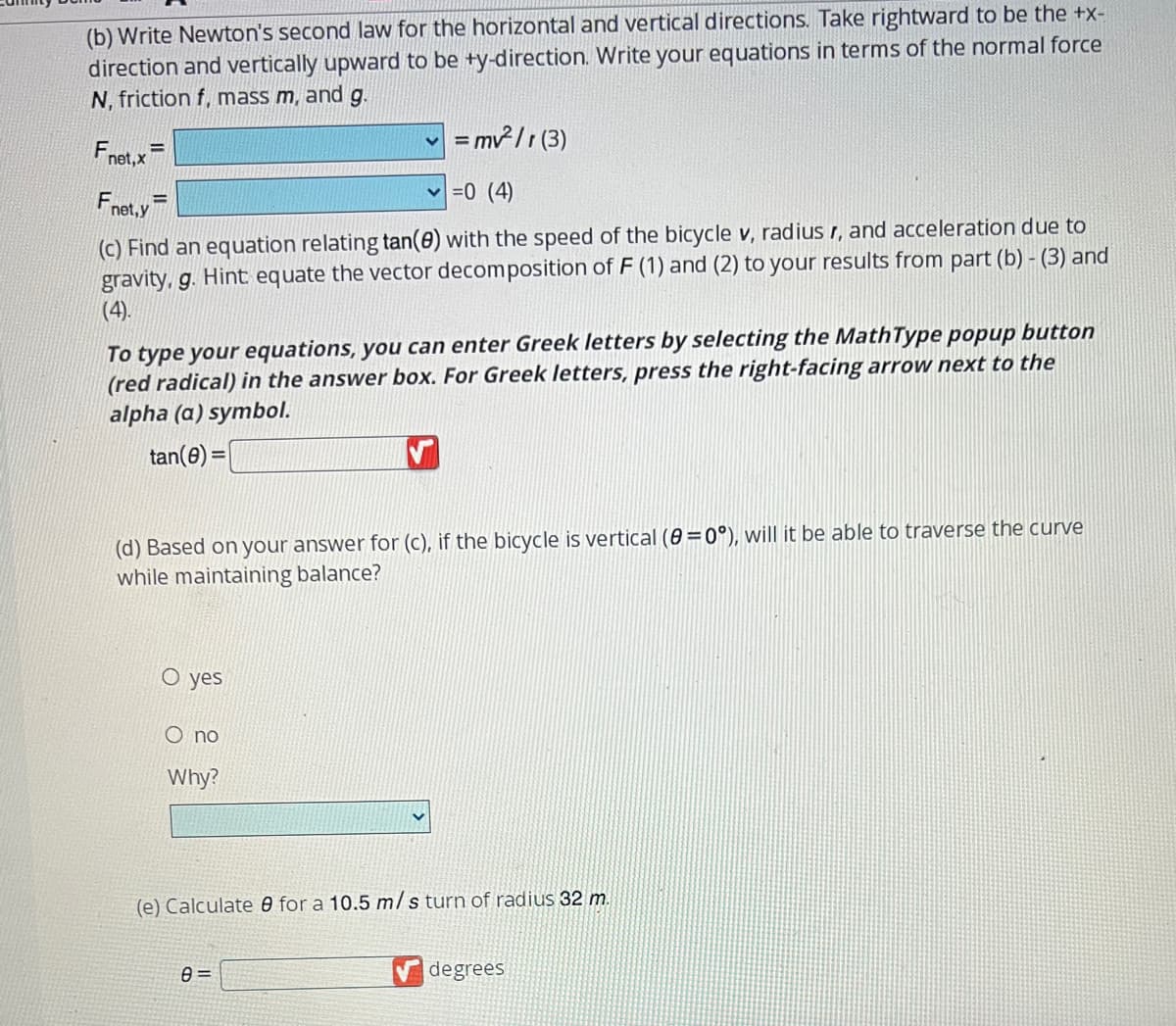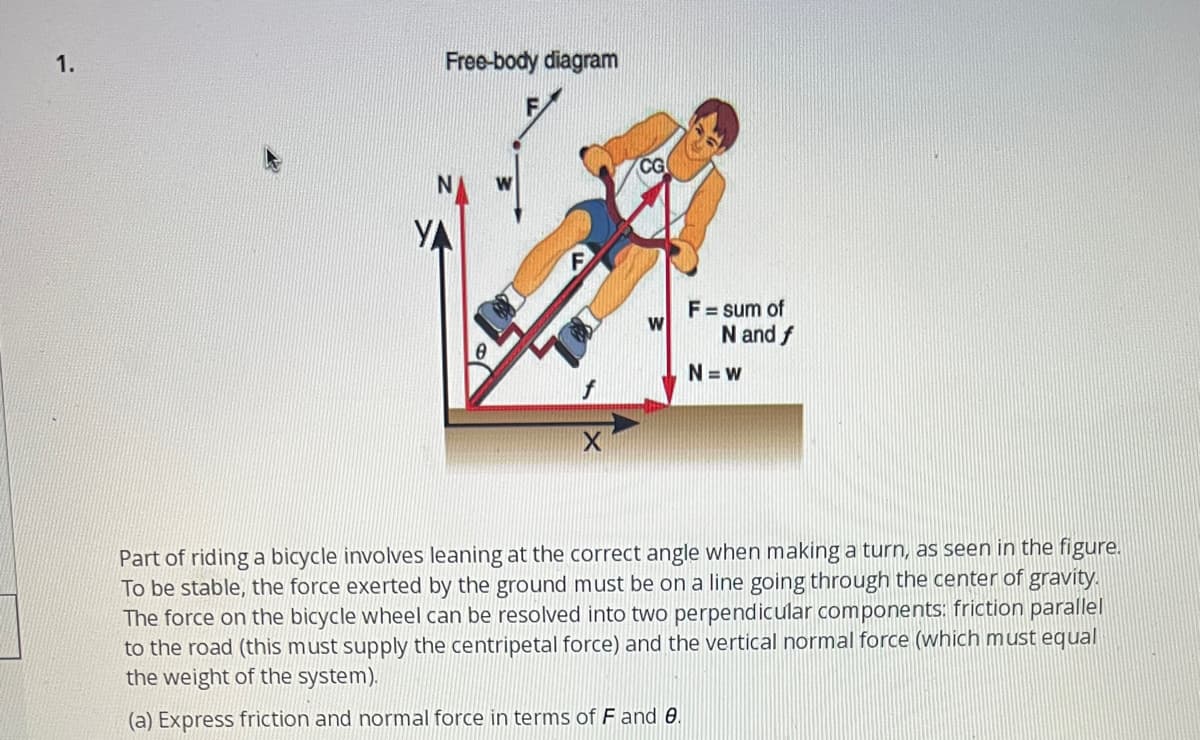1. Free-body diagram X W F = sum of N and f N=w Part of riding a bicycle involves leaning at the correct angle when making a turn, as seen in the figure. To be stable, the force exerted by the ground must be on a line going through the center of gravity. The force on the bicycle wheel can be resolved into two perpendicular components: friction parallel to the road (this must supply the centripetal force) and the vertical normal force (which must equal the weight of the system). (2) Express friction and normal force in terms of F and A
1. Free-body diagram X W F = sum of N and f N=w Part of riding a bicycle involves leaning at the correct angle when making a turn, as seen in the figure. To be stable, the force exerted by the ground must be on a line going through the center of gravity. The force on the bicycle wheel can be resolved into two perpendicular components: friction parallel to the road (this must supply the centripetal force) and the vertical normal force (which must equal the weight of the system). (2) Express friction and normal force in terms of F and A
University Physics Volume 1
18th Edition
ISBN:9781938168277
Author:William Moebs, Samuel J. Ling, Jeff Sanny
Publisher:William Moebs, Samuel J. Ling, Jeff Sanny
Chapter6: Applications Of Newton's Laws
Section: Chapter Questions
Problem 70P: Part of riding a bicycle involves leaning at the correct angle when making a turn, as seen below. To...
Related questions
Question

Transcribed Image Text:(b) Write Newton's second law for the horizontal and vertical directions. Take rightward to be the +x-
direction and vertically upward to be +y-direction. Write your equations in terms of the normal force
N, friction f, mass m, and g.
✓ = mv²/r (3)
Fnet, x
✓=0 (4)
Fnet,y E
(c) Find an equation relating tan(0) with the speed of the bicycle v, radius r, and acceleration due to
gravity, g. Hint equate the vector decomposition of F (1) and (2) to your results from part (b) - (3) and
(4).
To type your equations, you can enter Greek letters by selecting the MathType popup button
(red radical) in the answer box. For Greek letters, press the right-facing arrow next to the
alpha (a) symbol.
tan(8) =
V
(d) Based on your answer for (c), if the bicycle is vertical (8=0°), will it be able to traverse the curve
while maintaining balance?
O yes
O no
Why?
(e) Calculate for a 10.5 m/s turn of radius 32 m.
8=
degrees

Transcribed Image Text:1.
Free-body diagram
YA
F
X
CG
F = sum of
N and f
N=w
Part of riding a bicycle involves leaning at the correct angle when making a turn, as seen in the figure.
To be stable, the force exerted by the ground must be on a line going through the center of gravity.
The force on the bicycle wheel can be resolved into two perpendicular components: friction parallel
to the road (this must supply the centripetal force) and the vertical normal force (which must equal
the weight of the system).
(a) Express friction and normal force in terms of F and 8.
Expert Solution
This question has been solved!
Explore an expertly crafted, step-by-step solution for a thorough understanding of key concepts.
Step by step
Solved in 5 steps with 5 images

Knowledge Booster
Learn more about
Need a deep-dive on the concept behind this application? Look no further. Learn more about this topic, physics and related others by exploring similar questions and additional content below.Recommended textbooks for you

University Physics Volume 1
Physics
ISBN:
9781938168277
Author:
William Moebs, Samuel J. Ling, Jeff Sanny
Publisher:
OpenStax - Rice University

College Physics
Physics
ISBN:
9781938168000
Author:
Paul Peter Urone, Roger Hinrichs
Publisher:
OpenStax College

College Physics
Physics
ISBN:
9781305952300
Author:
Raymond A. Serway, Chris Vuille
Publisher:
Cengage Learning

University Physics Volume 1
Physics
ISBN:
9781938168277
Author:
William Moebs, Samuel J. Ling, Jeff Sanny
Publisher:
OpenStax - Rice University

College Physics
Physics
ISBN:
9781938168000
Author:
Paul Peter Urone, Roger Hinrichs
Publisher:
OpenStax College

College Physics
Physics
ISBN:
9781305952300
Author:
Raymond A. Serway, Chris Vuille
Publisher:
Cengage Learning

College Physics
Physics
ISBN:
9781285737027
Author:
Raymond A. Serway, Chris Vuille
Publisher:
Cengage Learning

Physics for Scientists and Engineers, Technology …
Physics
ISBN:
9781305116399
Author:
Raymond A. Serway, John W. Jewett
Publisher:
Cengage Learning

Glencoe Physics: Principles and Problems, Student…
Physics
ISBN:
9780078807213
Author:
Paul W. Zitzewitz
Publisher:
Glencoe/McGraw-Hill